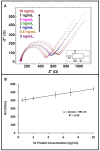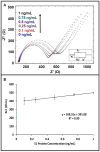Impedimetric Detection Based on Label-Free Immunoassay Developed for Targeting Spike S1 Protein of SARS-CoV-2
- PMID: 36010342
- PMCID: PMC9407092
- DOI: 10.3390/diagnostics12081992
Impedimetric Detection Based on Label-Free Immunoassay Developed for Targeting Spike S1 Protein of SARS-CoV-2
Abstract
After the COVID-19 pandemic started all over the world, great importance was placed on the development of sensitive and selective bioanalytical assays for the rapid detection of the highly pathogenic SARS-CoV-2 virus causing COVID-19 disease. In this present work, an impedimetric immunosensor was developed and applied for rapid, reliable, sensitive and selective detection of the SARS-CoV-2 S1 protein. To detect the SARS-CoV-2 virus, targeting of the spike S1 protein was achieved herein by using S1 protein-specific capture antibody (Cab-S1) immobilized screen-printed electrode (SPE) in combination with the electrochemical impedance spectroscopy (EIS) technique. With the impedimetric immunosensor, the detection limit for S1 protein in buffer medium was found to be 0.23 ng/mL (equal to 23.92 amol in 8 µL sample) in the linear concentration range of S1 protein from 0.5 to 10 ng/mL. In the artificial saliva medium, it was found to be 0.09 ng/mL (equals to 9.36 amol in 8 µL sample) in the linear concentration range of S1 protein between 0.1 and 1 ng/mL. The selectivity of the impedimetric immunosensor toward S1 protein was tested against influenza hemagglutinin antigen (HA) in the buffer medium as well as in artificial saliva.
Keywords: COVID-19; SARS-CoV-2 S1 protein; electrochemical immunosensors; electrochemical impedance spectroscopy.
Conflict of interest statement
The authors declare no conflict of interest.
Figures






Similar articles
-
Amperometric immunosensor developed for sensitive detection of SARS-CoV-2 spike S1 protein in combined with portable device.Talanta. 2022 Jul 1;244:123422. doi: 10.1016/j.talanta.2022.123422. Epub 2022 Mar 29. Talanta. 2022. PMID: 35395458 Free PMC article.
-
A Label-Free Electrochemical Impedimetric Immunosensor with Biotinylated-Antibody for SARS-CoV-2 Nucleoprotein Detection in Saliva.Biosensors (Basel). 2022 Apr 22;12(5):265. doi: 10.3390/bios12050265. Biosensors (Basel). 2022. PMID: 35624566 Free PMC article.
-
Optimized aptamer-based next generation biosensor for the ultra-sensitive determination of SARS-CoV-2 S1 protein in saliva samples.Int J Biol Macromol. 2024 Nov;281(Pt 1):136233. doi: 10.1016/j.ijbiomac.2024.136233. Epub 2024 Oct 1. Int J Biol Macromol. 2024. PMID: 39362419
-
Surface chemistry applications and development of immunosensors using electrochemical impedance spectroscopy: A comprehensive review.Environ Res. 2023 Nov 15;237(Pt 1):116877. doi: 10.1016/j.envres.2023.116877. Epub 2023 Aug 12. Environ Res. 2023. PMID: 37579966 Review.
-
Recent Developments in Electrochemical-Impedimetric Biosensors for Virus Detection.Int J Mol Sci. 2022 Dec 14;23(24):15922. doi: 10.3390/ijms232415922. Int J Mol Sci. 2022. PMID: 36555560 Free PMC article. Review.
Cited by
-
Advances in nanobiosensors during the COVID-19 pandemic and future perspectives for the post-COVID era.Nano Converg. 2024 Jan 11;11(1):3. doi: 10.1186/s40580-023-00410-5. Nano Converg. 2024. PMID: 38206526 Free PMC article. Review.
References
-
- Hoffmann M., Kleine-Weber H., Schroeder S., Krüger N., Herrler T., Erichsen S., Schiergens T.S., Herrler G., Wu N.H., Nitsche A., et al. SARS-CoV-2 Cell Entry Depends on ACE2 and TMPRSS2 and Is Blocked by a Clinically Proven Protease Inhibitor. Cell. 2020;181:271–280.e8. doi: 10.1016/j.cell.2020.02.052. - DOI - PMC - PubMed
-
- Fabiani L., Saroglia M., Galatà G., De Santis R., Fillo S., Luca V., Faggioni G., D’Amore N., Regalbuto E., Salvatori P., et al. Magnetic beads combined with carbon black-based screen-printed electrodes for COVID-19: A reliable and miniaturized electrochemical immunosensor for SARS-CoV-2 detection in saliva. Biosens. Bioelectron. 2021;171:112686. doi: 10.1016/j.bios.2020.112686. - DOI - PMC - PubMed
Grants and funding
LinkOut - more resources
Full Text Sources
Miscellaneous

